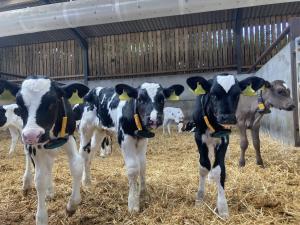
By vet Anne Abbs
Salmonellosis is caused by a group of related bacteria which can pass between species including human infection (zoonosis).
Depending on the species infected and the type of Salmonella it can cause a range of symptoms and can also cause asymptomatic carrier animals which can still shed bacteria, particularly at times of stress.

Calves can carry bacteria from the calving area into calf accommodation and infection can then spread by direct contact or from contaminated equipment such as buckets and even the wellies of the calf feeder. Classically calves will scour with a high temperature, rapid decline and high mortality, particularly in a herd with no previous exposure. However, the bacteria circulate in the body and can cause a range of other issues including septicaemia, pneumonia and joint infections.
Salmonella dublin in cattle may settle in the vertebrae of the spine resulting in spinal abscesses and a calf that struggles to stand or maybe down with no obvious limb injuries. Calves that survive often have poor growth and fail to reach target weights.
In adult cattle scour can occur (particularly with Salmonella typhimurium) but is less common and abortion is a more frequent symptom. In a naïve herd, abortion storms are possible. Cows frequently retain their cleansings and often milk poorly. Salmonella can also cause abortion in sheep with the ewe frequently having a high temperature and being ill before aborting. The foetus and membranes in both cattle and sheep can be carrying Salmonella so care should be taken if assisting an aborting animal e.g. by wearing gloves, to reduce the risk of human infection.
Herd infection may occur due to the unwitting purchase of an asymptomatic carrier or faecal contamination of feed. It is therefore important to ensure all equipment and people that come onto the farm are clean and disinfected, and feed stores are protected from contamination including vermin. Don’t forget water sources – infection has been spread by stock drinking beck water when an upstream farm had Salmonellosis!
If Salmonella is diagnosed on your farm it is important to try and limit the spread as much as possible. Also consider anyone who is vulnerable to infection such as children or people with immune suppression and protect them (leave the dirty overalls outside particularly if you have been handling sick calves or aborting animals). Raw milk is a source of infection so consider who may drink this.
Other measures that can help include:
Isolating aborting animals and keeping sick animals out of the calving/lambing pens
Removing calves from the calving pen promptly and disinfect buckets thoroughly between calves or keep a bucket for each calf. Try to isolate any calves showing symptoms and feed them at the end of the feed then wash and disinfect wellies, the milk taxi and any other equipment before the next feed.
Don’t feed milk from sick cows to calves. Even if you only give it to the beef calves unless they are in a separate shed from the dairy calves there is still a cross contamination risk.
Consider vaccination. Unfortunately, at the moment there are some supply issues with vaccines but when they are available they can greatly reduce the issues that Salmonella creates. Whole herd vaccination is normally recommended followed by booster doses particularly in dry cows to provide protection to calves through the colostrum. Vaccination will not remove the carrier status of cows that have had infection and not cleared it from the system, so you need to be wary of thinking the problem has gone away after several years of vaccinating only for the whole problem to start again because there are still carriers in the herd.